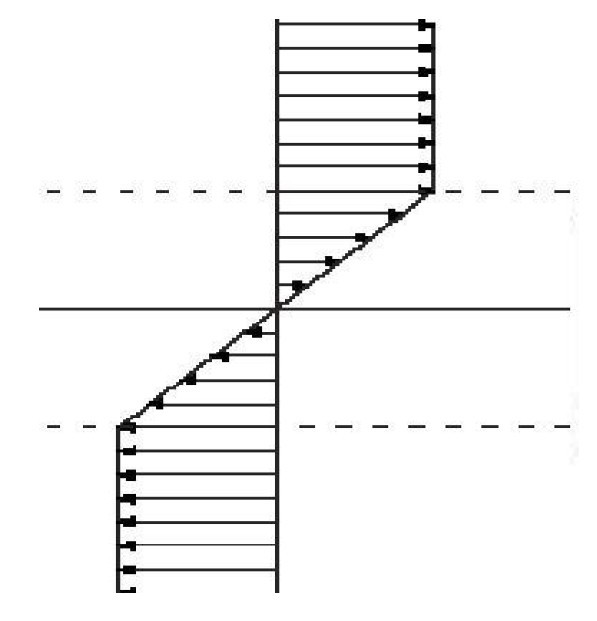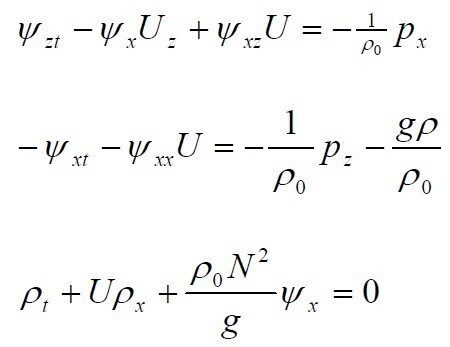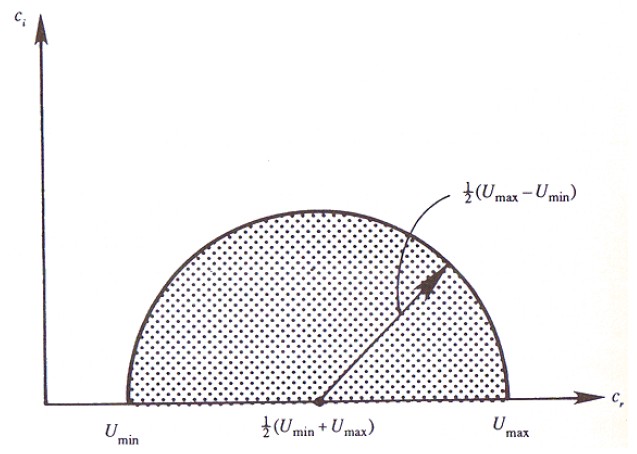Instability of Continuously Stratified
Parallel Flows
1,Taylor-Goldstein
Equation
2,The
Gradient Richardson Number
3,The
behavior of the phase speed c
We assume a basic state
of a continuous stratified parallel flows, which can be
illustrated by the figure below.

1,Taylor-Goldstein
Equation
Assume
the basic state can be characterized by U,P and  .
Then we add a disturbance to the system. Then the system can
be characterized by
.
Then we add a disturbance to the system. Then the system can
be characterized by
 ,
, and
and

As we assumed
before, the momentum equations become:

The basic state satisfies:

Here  is a
reference density. Subtracting the last two equations and
dropping nonlinear terms ,we get:
is a
reference density. Subtracting the last two equations and
dropping nonlinear terms ,we get:

Using  , or
, or
 .
.
Drop nonlinear terms ,we get

Which can be written as

in which N is the buoyancy frequency of the flow:

To meet the continuity equation, we assume a stream
function  , which satisfies
, which satisfies

Then then equations we got before can be written as

Since the coefficients in these equations are
independent of x and t, we can assume that the solutions
have the form of

After some elimination, we can get the equation for
 :
:

This is the Taylor-Goldstein equation
2, The
Gradient Richardson Number
Since the property of the Taylor-Goldstein
equation, a nonzero ci ensures instability. (see Kundu Sec.
11.7)
The boundary conditions are what w=0 on rigid
boundaries, namely z=0 and z=d. This means that

namely

Define a new field variable  by
by

After a series of math, the Taylor-Goldstein
equation becomes(See Kundu Sec. 11.7)

Multiply this equation by  , which is the complex
conjugate of
, which is the complex
conjugate of  ,
integrate from z=0 to z=d,and use the boundary conditions
,
integrate from z=0 to z=d,and use the boundary conditions  ,
we can obtain:
,
we can obtain:

Obviously, the integral on the right hand side is
positive. If  everywhere, then ci times a positive value equals -ci times
a positive value. That means ci=0, which indicates that the
system is stable. So define the gradient Richardson
Number:
everywhere, then ci times a positive value equals -ci times
a positive value. That means ci=0, which indicates that the
system is stable. So define the gradient Richardson
Number:

We say stability is guaranteed if:
Ri>(1/4)
We need to point out that the criterion doesn't
guarantee that the flow is unstable if Ri<(1/4) somewhere
,or even everywhere. So Ri<(1/4)
is a necessary but not sufficent condition for
instability. Actually, there is no unique lower
boundary of Richardson Number that guarantee instability for
all distributions of U(z) and N(z).
3, The
behavior of the phase speed c
Similar to previous analsis, but define a different
field variable F by:

we can get

in which

For instability, Ci is nonzero. That means (U-Cr)
must change sign somewhere:

whice means that Cr lies in the range
of U. Since Cr is the phase velocity in the positive x
direction. The inequality above means that Cr is positive if
U is positive everywhere and negative if U is negative
everywhere.
We can also get the properties of Ci. According to Kundu
Sec. 11.7, Ci satisfies:

This relation is first derived by Howard (1961), so
it's called Howard semi-circle theorem.It can
be illustrated by the figure below (pitcure from Kundu Sec.
11.7)





 .
.












